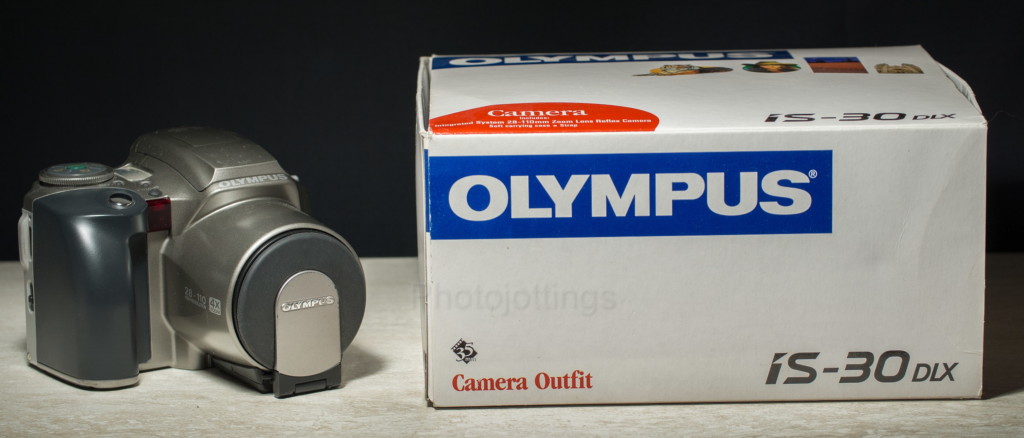
I’ve probably owned north of 100 film cameras just in the last ten years, and the Olympus IS-30 DLX is one of, if not thee best 35mm film camera bargain out there. This camera goes for an astonishingly low price on ebay, and picking up a decent working model will set you back about the same as a burger and fries at McDonald’s. Check out the newer, more advanced Olympus IS-5 model I reviewed here.
The Olympus IS-30 has an excellent 28-110mm fixed zoom lens, along with all the conveniences and necessities that we demand today for our expensive digital cameras; such as predictive AF, TTL phase-difference detection system; TTL light metering and fuzzy logic ESP metering for back-lit scenes and ±2ev exposure compensation. Also included are; auto advance, rewind and loading; powerful flash with high speed sync; aperture priority mode and a whole lot more.
The exposure system is first rate, and it nails slide film just as good as the Nikon 35Ti with its fancy matrix metering. This super zoom bridge type camera focuses exceptionally fast, especially for back in the late nineties, and by looking through the viewfinder you see the changes made instantly like focusing and filter effects; again, just like an SLR.
Of course there are the typical goofy 1990s features on this 1999 camera that no one cares about anymore like ‘panorama’ mode, ‘creative’ flash effects, and those expensive Olympus teleconverters that never get used, and show up now on ebay brand new in the box for next to nothing.
The Olympus IS-30 DLX is marketed as a ‘ZLR’ which is a ‘zoom lens reflex’ camera, with all the nice features you’d find on a Canon, Nikon or Minolta ‘SLR’ of the day. So how well does it actually work? Let’s find out below!
Name; Olympus IS-30 DLX; IS-300 in Europe, and L-30 in Japan. Our review model is marked as IS-30 DLX (101-740).
Manufactured by; Olympus Optical company LTD, Tokyo, Japan.
Made in; China, using Japanese parts.
Date of manufacture; 1999-?
Price; receipt from Wolf Camera dated September 2001 showed the final sale price as $399.95, so probably around $450 or more at introduction. Current eBay prices range anywhere from $10 to $50 depending on condition and if it comes with the original box or is refurbished etc. I paid $26.00 including shipping for my ‘outfit’.
Build material; appears to be a metal frame with a plastic skin. Fit and finish are ordinary to very good.
Box contents; Camera, soft case, shoulder strap, instruction manual in multiple languages, and maybe some batteries.
Weight; my measurements; camera with batteries, 24.1oz (684g).
Dimensions; my measurements; 5.1″ (125mm) long, 3.4″ (85mm) tall, and 4.7″ (120mm) deep, and 6.5″ (165mm) with lens extended.
Focal length; 28-110mm zoom.
Aperture; F/4.5 maximum at wide end, F/5.6 at the long end. F/22 minimum. Changeable in full stop increments only.
ISO; 25-3200 DX coded. Defaults to ISO 32 for non-DX coded film. Settings are: 25, 32, 50, 64, 100, 125, 200, 250, 400, 500, 800, 1000, 1600, 2000, 3200). Other intermediate film speeds are automatically set for the next lower speed.
Focusing distance; 2.5′ to infinity, or 0.75m to infinity.
Viewfinder; just like a real SLR, and with a -2∼+1 diopter adjustment!! Has 85% FOV, and magnification of 0.72 at 50mm. Viewfinder information includes; autofocus frame, spot frame, panorama frame, autofocus indicator, flash indicator (to be used as flash warning), overexposure/underexposure indicator.
Approximate resolution; good film and technique will make very sharp 11×14″ prints. See sample images farther down the page.
Lens; 28-110mm 4x zoom; 11 elements in 9 groups, with a 5 group zoom construction. Has ‘glass aspherical’ lens element. Lens cover attached to lens. Uses 52mm filters, B&H, Amazon, eBay.
Shutter and speed; electronic; 1/2000 to 1/15 in auto mode, one minute max in ‘LT’ mode.
Date back; goes to 2049, so Olympus figured the camera would last 50 years! User replaceable CR2025 coin cell battery attached to camera back cover.
Film; standard 35mm cartridges.
Flash; capable of variable flash output depending on scene and distance to camera. ‘FP’ short for ‘focal plane’ and twin flash are the same. The camera has a regular flash for wider coverage, and a Syncs at ‘under’ 1/100. Will do up to 1/2000 in ‘portrait’ mode only. Four second recycle time at maximum power, with a claimed guide number of 25; more like 12 at wide angle ISO 100 with regular flash.
Power; two CR123A 3V batteries; B&H, Amazon, eBay. Date back uses internal CR2025.
Accessories for this model; REMOTE CONTROL RC200, C-210 H.Q.CONVERTER 1.9X, C-160 H.Q. CONVERTER 1.45X, and ACTION CASE C. RC100 remote will work according to the owner’s manual.
Crippling features and omissions; flash sync too slow, and causes problems when trying to use fill flash at wide apertures and shutter speed above 1/100; however, you can use portrait mode and get high speed sync. Batteries may not be available at normal locations like grocery store etc, plus they’re expensive.
Good features; excellent exposure metering and fast and accurate focusing. Relatively small and lightweight, about the same size and weight as an entry level Nikon N65 with prime lens, see image below.
Quirks; none other than what I mentioned above.
Other versions; there are several other versions of the IS series going back to 1990.
Go here to see the owners manual.
Product shots with descriptions. Click pictures for larger versions.

Original camera outfit, camera, vinyl case, (not shown here), neck strap, batteries and all the manuals.

The Olympus IS-30 DLX uses a spring loaded lens cap that is pushed open when the lens extends, and you manually flip it closed with your fingers. You can mount a filter and still close the cap; it’s held on by rubber bands and is very difficult to break off; you can even take it off completely if you want.

The combined power and flash button is the only control on the left side.

The lens extends about 2.2″ (55mm) at the wide and long end, and is shortest at the mid lengths. Also, the lens doesn’t rotate, so you can use your polarizers and ND grads with no fuss.

The ‘twin’ flash pops up by sliding the power button all the way back, and will not pop up automatically in low light. Olympus calls it a ‘twin flash’ and ‘Super FP flash,’ which is confusing, but here’s the gist; the top part of the flash is used at the wider end of the zoom, and the lower part for longer zoom lengths. Super FP or ‘focal plane’ is the same as modern HSS, or high speed sync, and is used for syncing the flash beyond the normal 1/100s maximum: here the flash uses a series of very short duration emissions while the shutter traverses over the frame, however the penalty is a very weak flash, that’s why it only works in ‘Portrait’ mode, and close to your subject.
The small square red panel is for the 12 second self timer, staying solid red for 10 seconds, and flashing the last two seconds before tripping the shutter.

The 28-110mm lens uses an aspherical element, and zooms internally in addition to the lens extension. The extension is shortest at mid zoom lengths.

On the back of the camera there are several features to point out: the Quartzdate is good until 2049, however, if the coin cell CR2025 battery is dead, obviously you can’t use it. Fortunately, the battery is located behind the pressure plate, and all you need is a little finger dexterity and a small phillips screwdriver to replace it.
The green text on the right side of the viewfinder warns you of the idiotic panorama mode. At least you can turn it on or off for each shot, and is shows the crop in the viewfinder.
The little wheel on the left side of the viewfinder is the diopter adjuster, which corrects for abnormal vision. This is a really nice feature for people that wear eye glasses.
The remote switch is just to the left of the Diopter adjuster; push this twice for setting the timer, or once for using the RC200 controller.
The zoom toggle is in the upper right, and zooms the lens in a continuous motion if held down.
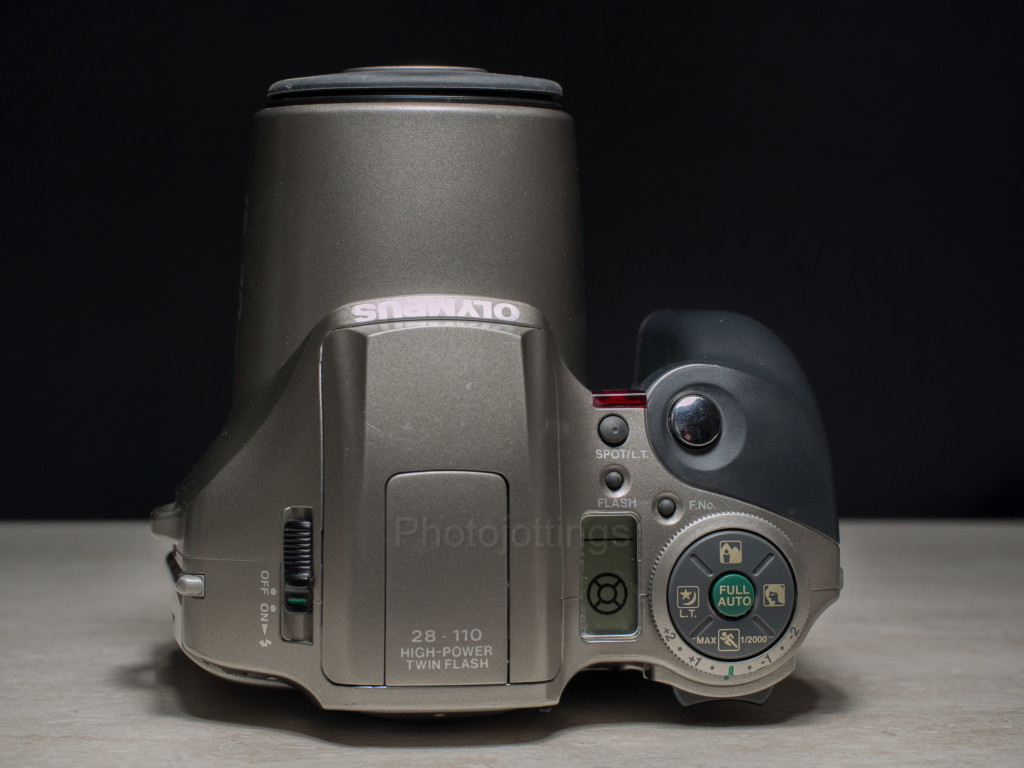
The majority of the controls are located on the top right of the camera. The top gray button is for spot metering, or ‘long time’ mode in which you can keep the shutter open for up to 60 seconds***. The large chrome button trips the shutter. The little gray button below the spot/LT cycles through the flash settings when the flash is raised. The ‘F.No.’ button puts the camera in aperture priority mode, and cycles through the aperture settings in one stop increments.
The circular control pad has an outer rotating ring for exposure compensation. The middle green button is for putting the camera in full automatic mode. The top image with the mountains and person is for landscape scenes. The head of a woman is for portraits, and prioritizes wide apertures and high speed sync for fill flash. The square with a star and moon sliver is for night scenes. The guy running is ‘stop action’ shooting and prioritizes fast shutter speeds.
***for setting long exposures, press and hold the ‘LT’ night scene button, and simultaneously push the spot/LT button until you get to your required shutter speed of; 1s, 2s, 4s, 8s, 15s, 30s, and 60s.

Inside the back cover looks very similar to an SLR. Here you’ll find a metal pressure plate, film reminder window, and a vertical traversing focal plane shutter; don’t touch the blades!! The date back battery is behind the film pressure plate.

This will give you a rough idea on how to replace the date battery. First, take out the film pressure plate, no tools are required. Next, remove the three screws that hold the LCD and coin cell battery box to the back cover. The CR2025 battery comes out by lifting to the side, no tools required. Re-install in reverse. Make sure the mode/set/select buttons unit is placed back correctly, see pictured top right. With the new battery inserted, the date defaults to 1-1-98, so I guess they finalized the read-only-memory a year or so before the camera hit the shelves.

Looking beyond the dirt and scuffs on the camera, we can see the battery compartment that uses 2 CR123A batteries, a mid-roll rewind button to the right, and an off-center tripod socket in an anti-spin grip pad.

The small Nikon N65 with 24/2.8 on the left, Oly IS-30 on right. They’re both very similar in size and weight. The original cheap vinyl carrying case in the back. Unfortunately, the camera barely fits the case, and it takes a bit of doing to get it in and out, so most likely you’ll end up destroying the case in a fit of rage; but it looks cool in the box as part of the ‘outfit.’
Sample shots below.
Here are a few samples for your viewing pleasure. They’re around 4000 pixels wide, so click image for a larger version. Scanned on a Nikon Coolscan 9000 ED.

Come sit a spell. F/8, 28mm, -0.5ev. A very sharp image, even along the extreme sides and corners. Fuji Velvia 100

Spanish Hacienda. F/8, 28mm. Kodak Gold 200.
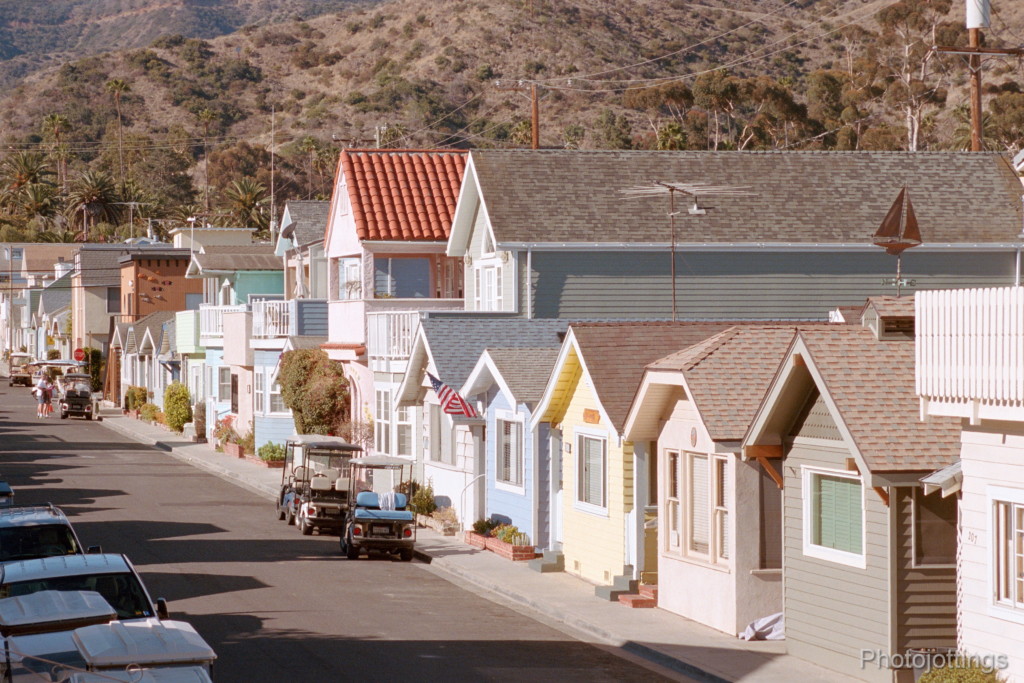
Tiny homes and cars. 110mm, F/8? Kodak Portra 400.

A ship loaded with Teenagers for spring break; what could go wrong? Taken at 110mm, about F/8, -0.5ev. Fuji Velvia 100
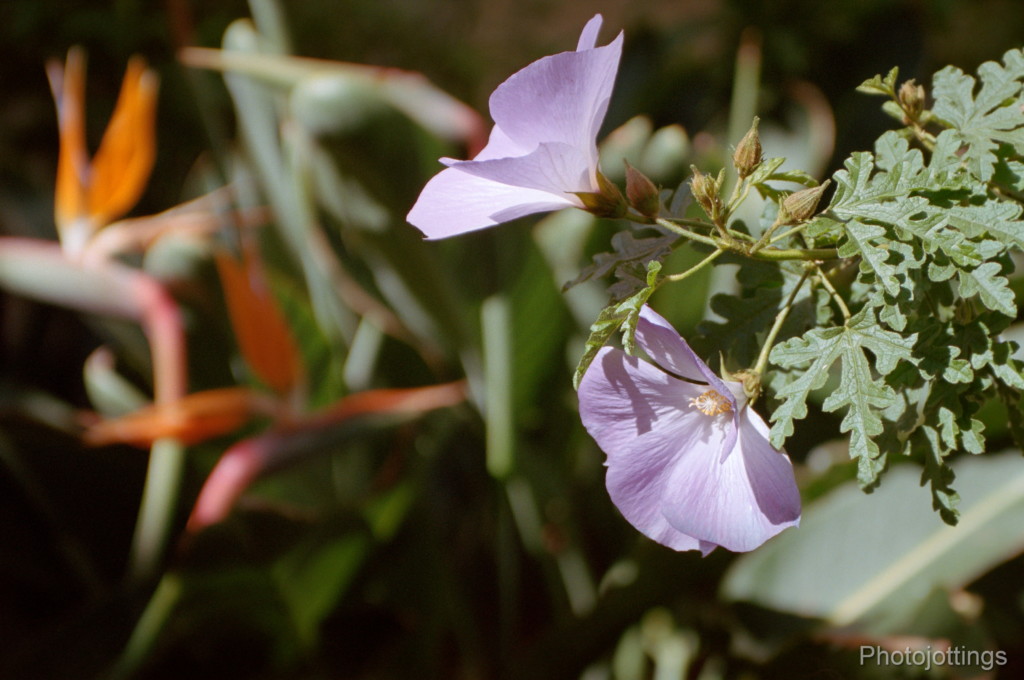
Close focus I think at 110mm. Pretty smooth blur here, and it nailed the focus. Kodak Portra 400.

I think around 50mm, close focus. CineStill 50D.

Blue Chalk. Close focus at 110mm, -0.5ev. Fuji Velvia 100

Through the fire at 110mm. Heat shimmer here from the fire. Kodak Portra 400.
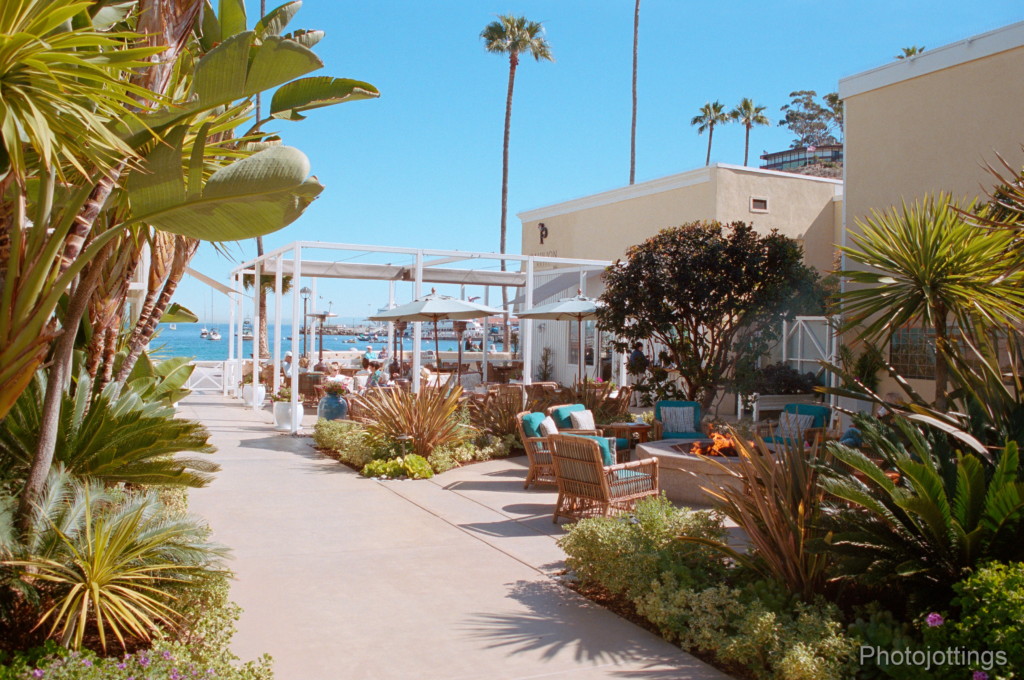
The hang-out, ‘just 20 steps to the beach.’ 28mm, nice and sharp across the frame. Kodak Portra 400.

Moderate to strong barrel distortion at 28mm.

Just a minor amount of pincushion distortion at 110mm.
Test scene below.
All test shots are displayed at approximately 4000 x 2667 pixels wide when enlarged, and that’s all the resolution included in the film. Scanned on a Nikon Coolscan 9000 ED. Tripod used, no filters.
I used CineStill 50D for the test shots which was probably a mistake; it’s good film but doesn’t show a lot of contrast which would be helpful here. With that said, you can still get a good idea of how the aperture affects the sharpness of the picture.
28mm

F/4.5. A bit soft all over, and the film was dirty by looking at the worms in the sky.

Moving to F/5.6 improves the contrast and sharpness quite a bit.

F/8. The sides sharpen a little more.

F/11, very sharp across the frame, the best for landscape scenes.
50mm
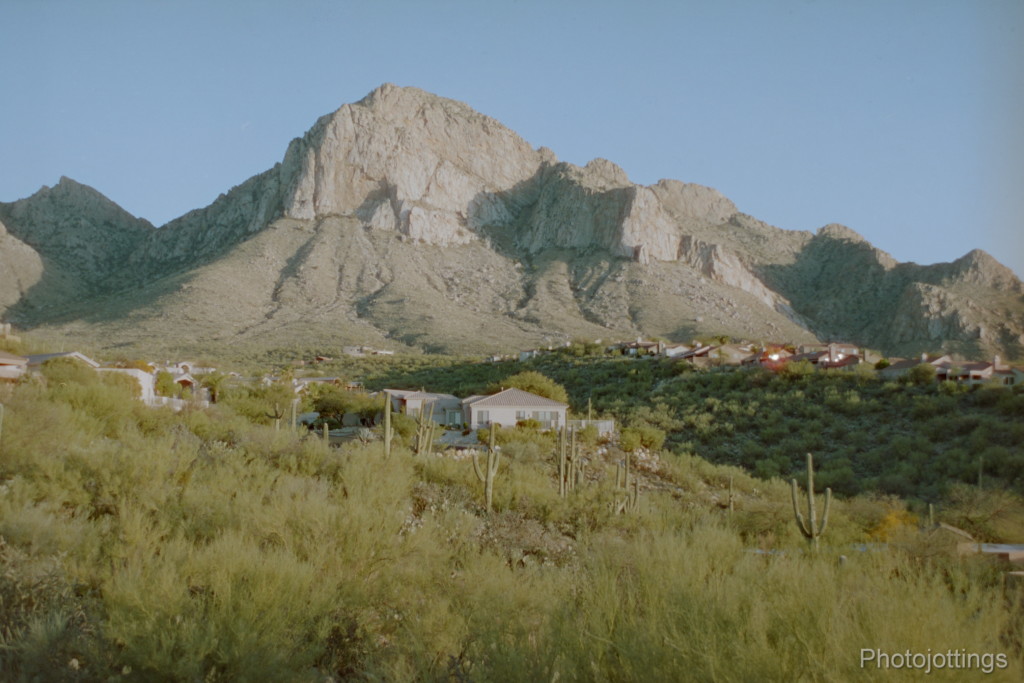
At F/5 the centers are a bit soft, and the sides are blurry.

F/8, not much difference here from F/5.
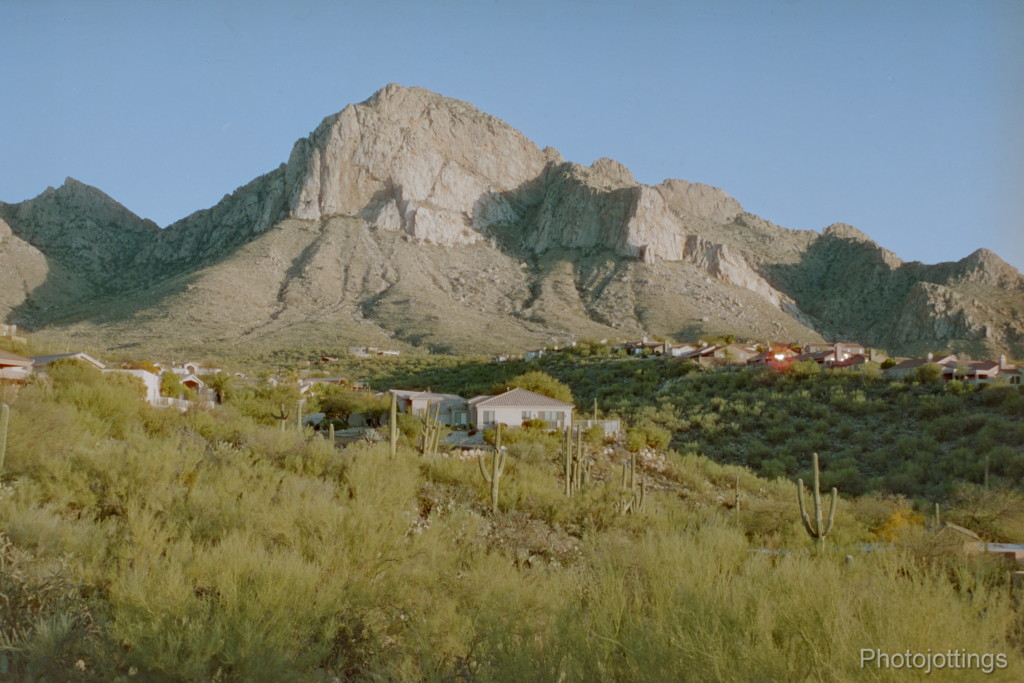
F/11, a nice jump in contrast and sharpness.
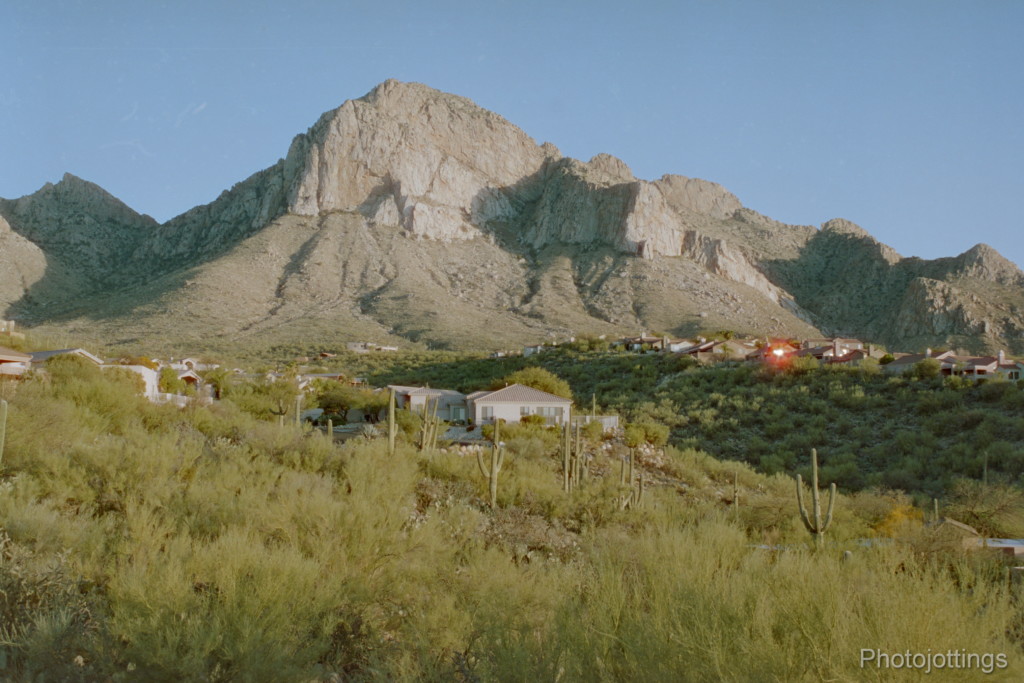
F/16, pretty sharp across the frame, the best aperture for landscape scenes.
110mm

F/5.6 A little soft all over, but not bad.

F/8, a minor bump up in sharpness.

F/11, about the same as F/8.

F/16, about the same as F/11. Landscape scenes are good from F/8-16. Contrast is lacking somewhat at the long end, but that’s very typical of most zoom lenses.
Note; again, these test pictures were taken on Kodak movie film that has had the rem-jet layer removed for standard C-41 color negative development, which does cause some issues. You’ll have to look past the odd red halos and low contrast to appreciate the quality of the lens. Sorry, but I had almost a full roll, and wanted to take the test shots while the weather was good.
Conclusion.
The Olympus IS-30 DLX is really a great camera for the price, pick one up for the price of a big mac or haircut. I found the focusing and exposure metering to be excellent, and I had no out of focus shots or bad light metering (even from two rolls of slide film) after taking 4 rolls of 36 exposure film. Also, the fuzzy logic electro selective pattern, or ‘ESP’ worked very well for back-lit shots on print as well as picky slide film. The aperture priority feature is very welcome, and when stopped down to F/11, you almost get prime lens performance throughout the zoom range, and through-the-lens convenience of an SLR.
A few other features I found very useful were the ‘long time’ exposure mode, high speed sync fill flash, the diopter viewfinder adjustment, and the exposure compensation dial.
The Olympus IS-30 DLX represents an excellent value for people that enjoy using modern features and through-the-lens conveniences of a 35mm SLR, but aren’t interested in carrying around extra lenses. Two thumbs up for this sleeper camera!
Check out my review of the newer and slightly more advanced Olympus IS-5 model.
Please consider buying through my links and help support the site. Thanks for visiting!